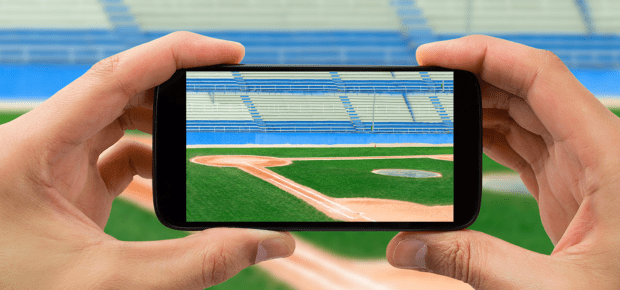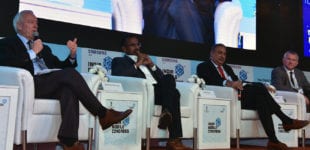April 20, 2018
Despite fact that parts of the U.S. are still experiencing below-freezing temperatures and even a little snow, the Major League Baseball season is in full swing. When heading out to watch a game in person, baseball fans want more than just the latest weather forecast at their fingertips. The ballgame experience now includes access to the latest stats, injury reports and roster moves instantaneously. Before smartphones, getting any inside scoop involved listening to the radio call of the game, or calling a family member sitting home watching the game on TV.
Today, watching a baseball game in person is a totally different experience due to the various statistics apps that are available. Even the casual baseball fan may use a smartphone to look up a player’s name or former team. “Old time” baseball stadiums, like Wrigley Field in Chicago, are staying ahead of the curve in upgrading their infrastructures so that fans can enjoy seamless data downloads.
On April 6, the Chicago Cubs announced a multi-year partnership with Comcast that included the installation of a “10 Gigabit dual-circuit fiber network, which will offer roughly 1,000 times more speed and capacity in the ballpark and surrounding area than what was previously available. That capacity will be more than enough to accommodate the network of WiFi access points,” according to the news release.
How much strain can thousands of fans using WiFi at the same time have on a network, and what is being done to maximize fans’ experiences? We asked IEEE Fellow and associate professor at the NYU Tandon School of Engineering, Sundeep Rangan, to shed some light on the emerging technologies behind improvements in network infrastructure:
“There are two emerging technologies that could deliver even higher data rates. The first is the use of high frequency millimeter wave (mmWave) bands. These have much wider bandwidths to provide higher capacity. They are also blocked by many common materials and can be transmitted in very narrow beams, so they are easier to isolate in a dense stadium setting. The mmWave bands are already used in the IEEE 802.11ad standard and are a key component of the 5G cellular standards that should be available soon.
A second potential method is so-called massive MIMO. In this solution, a large antenna with several elements communicates to a number of users with narrow beams. This method should also improve capacity in a stadium; however, most of the early field trials have focused on more traditional suburban and urban settings.”
Improved wireless capabilities may only be the tip of the iceberg for what we see in the sports stadiums of tomorrow. Who knows – in the coming years, fans might be able to order food and merchandise from their seats and have it delivered to them; or better yet, weigh in on whether or not it’s time to take a starting pitcher out of the game.





 Liquid Infrastructure: Our Planet's Most Precious Resource
Liquid Infrastructure: Our Planet's Most Precious Resource The Impact of Technology in 2025
The Impact of Technology in 2025 Quantum and AI: Safeguards or Threats to Cybersecurity?
Quantum and AI: Safeguards or Threats to Cybersecurity? Why AI Can't Live Without Us
Why AI Can't Live Without Us Bits, Bytes, Buildings and Bridges: Digital-Driven Infrastructure
Bits, Bytes, Buildings and Bridges: Digital-Driven Infrastructure Impact of Technology in 2024
Impact of Technology in 2024 Emerging AI Cybersecurity Challenges and Solutions
Emerging AI Cybersecurity Challenges and Solutions The Skies are Unlimited
The Skies are Unlimited Smart Cities 2030: How Tech is Reshaping Urbanscapes
Smart Cities 2030: How Tech is Reshaping Urbanscapes Impact of Technology 2023
Impact of Technology 2023 Cybersecurity for Life-Changing Innovations
Cybersecurity for Life-Changing Innovations Smarter Wearables Healthier Life
Smarter Wearables Healthier Life Infrastructure In Motion
Infrastructure In Motion The Impact of Tech in 2022 and Beyond
The Impact of Tech in 2022 and Beyond Cybersecurity, Technology and Protecting Our World
Cybersecurity, Technology and Protecting Our World How Technology Helps us Understand Our Health and Wellness
How Technology Helps us Understand Our Health and Wellness The Resilience of Humanity
The Resilience of Humanity Harnessing and Sustaining our Natural Resources
Harnessing and Sustaining our Natural Resources Creating Healthy Spaces Through Technology
Creating Healthy Spaces Through Technology Exceptional Infrastructure Challenges, Technology and Humanity
Exceptional Infrastructure Challenges, Technology and Humanity The Global Impact of IEEE's 802 Standards
The Global Impact of IEEE's 802 Standards Scenes of our Cyber Lives: The Security Threats and Technology Solutions Protecting Us
Scenes of our Cyber Lives: The Security Threats and Technology Solutions Protecting Us How Millennial Parents are Embracing Health and Wellness Technologies for Their Generation Alpha Kids
How Millennial Parents are Embracing Health and Wellness Technologies for Their Generation Alpha Kids Space Exploration, Technology and Our Lives
Space Exploration, Technology and Our Lives Global Innovation and the Environment
Global Innovation and the Environment How Technology, Privacy and Security are Changing Each Other (And Us)
How Technology, Privacy and Security are Changing Each Other (And Us) Find us in booth 31506, LVCC South Hall 3 and experience the Technology Moon Walk
Find us in booth 31506, LVCC South Hall 3 and experience the Technology Moon Walk Virtual and Mixed Reality
Virtual and Mixed Reality How Robots are Improving our Health
How Robots are Improving our Health IEEE Experts and the Robots They are Teaching
IEEE Experts and the Robots They are Teaching See how millennial parents around the world see AI impacting the lives of their tech-infused offspring
See how millennial parents around the world see AI impacting the lives of their tech-infused offspring Take the journey from farm to table and learn how IoT will help us reach the rising demand for food production
Take the journey from farm to table and learn how IoT will help us reach the rising demand for food production Watch technical experts discuss the latest cyber threats
Watch technical experts discuss the latest cyber threats Explore how researchers, teachers, explorers, healthcare and medical professionals use immersive technologies
Explore how researchers, teachers, explorers, healthcare and medical professionals use immersive technologies Follow the timeline to see how Generation AI will be impacted by technology
Follow the timeline to see how Generation AI will be impacted by technology Learn how your IoT data can be used by experiencing a day in a connected life
Learn how your IoT data can be used by experiencing a day in a connected life Listen to technical experts discuss the biggest security threats today
Listen to technical experts discuss the biggest security threats today See how tech has influenced and evolved with the Games
See how tech has influenced and evolved with the Games Enter our virtual home to explore the IoT (Internet of Things) technologies
Enter our virtual home to explore the IoT (Internet of Things) technologies Explore an interactive map showcasing exciting innovations in robotics
Explore an interactive map showcasing exciting innovations in robotics Interactively explore A.I. in recent Hollywood movies
Interactively explore A.I. in recent Hollywood movies Get immersed in technologies that will improve patients' lives
Get immersed in technologies that will improve patients' lives